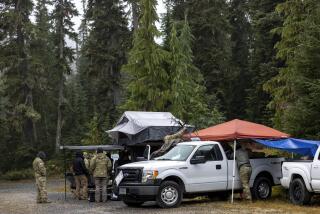Downed Marine Aircraft, 2 Bodies Found in Canyon
A Civil Air Patrol pilot Saturday spotted the wreckage of a Marine observation plane from Camp Pendleton that vanished in the desert more than two weeks ago. The downed aircraft was spotted in a remote wilderness area in Riverside County.
Military officials said the bodies of the two-man crew were recovered at the crash site by a team of Marines ferried to the rugged region in helicopters.
Authorities said the plane crashed about 10 miles north of Banning in a narrow canyon near San Gorgonio Mountain, a towering peak in the San Bernardino Mountains. The aircraft, an OV-10A Bronco, plowed into the base of the mountain pass at an altitude of about 6,100 feet, according to 1st Lt. Gene C. Brown, a spokesman at El Toro Marine Corps Air Station.
The twin-engine plane disappeared Aug. 24 during what was to be a routine, three-hour reconnaissance training flight. The pilot, Sergio Vivaldi, 29, of Port Chester, N.Y. and his observer, 1st Lt. Joel Piehl, of Bismarck, N.D. made no radio contact to report problems, and air-traffic control radar was unable to track them.
When the aircraft failed to turn up, about 150 planes manned by Marine Corps pilots and civilian volunteers spent days scouring the mountains and more than 324,000 square miles of Southern California desert between the Mexican border and Nevada.
The wreckage was found in an area of rugged gorges and mountain peaks that had been searched repeatedly by Marine helicopters and civilian planes after witnesses reported seeing black smoke on the day the plane disappeared.
Keith Kelley, a retired Air Force search-and-rescue squadron commander, spotted the Marine plane while making a pass through the region in a fixed-wing aircraft.
A Civil Air Patrol volunteer with numerous sightings to his credit, Kelley had searched the area around San Gorgonio Mountain repeatedly in the past two weeks before he made his discovery early Saturday morning, military officials said.
But it didn’t come easily.
Kelley said he had suspected for several days that the Marine plane might have gone down in the canyon, a quarter-mile-wide gorge about two miles southeast of the mountain. With sheer walls rising 3,000 feet and devastating downdrafts that can whip a small plane like a bucking bull, the canyon is a treacherous place to fly, he said.
“That canyon is the worst aircraft trap I’ve ever seen,” Kelley said. “There are real steep walls, and you can’t turn out of it because it’s too narrow. And there’s severe winds. It’s mind-boggling.”
On Thursday, Kelley said, calm winds allowed him to pilot his single-engine Cessna safely between the towering cliffs, which run about four miles before hugging together at the canyon’s end.
During several passes through the gorge, Kelley and an observer spotted glints of green and orange they suspected might be parts of the plane or a parachute. Repeat passes, however, failed to turn up any direct evidence of the downed plane, he said.
Buoyed by the clues, Kelley on Friday night asked the San Bernardino County Sheriff’s Department to send a helicopter into the canyon the next morning. By 8:30 a.m. Saturday, the sheriff’s helicopter had sighted the shattered, burned-out wreckage of the small Marine plane. The aircraft had plowed nose first into a crevice at the base of the canyon, which is part of the San Gorgonio Wilderness Area.
Brown said Marine Corps investigators were flown from Orange County to the far-flung crash site in military helicopters. The rugged terrain made it difficult to land, but investigators managed to hike to the crash site by 4 p.m. and confirm that it was the Marine aircraft and locate the bodies of the two crewmen.
Military investigators had not yet determined what caused the plane to crash but would continue to probe the wreckage in the coming days for clues, Brown said.
Kelley said the discovery was among the most memorable he can recall. The aircraft was wedged so well into the canyon that sighting it was nearly impossible from all but close range.
“In 48 years of doing this kind of thing, this has to be one of the most difficult I’ve ever seen,” he said. “It looked like it went straight into a crevice. He came straight in on his nose. All the wreckage was combined in one area except a piece of orange parachute.”
Although military planes disappear from time to time on practice flights, authorities say they are typically located within days or hours, making the long search for the OV-10A Bronco somewhat unusual.
Even before the discovery Saturday, military officials said it seemed unlikely that survivors would be found, noting that no distress signals had been picked up from the pocket-held emergency beepers that all Marine fliers are required to wear in the event they go down.
More to Read
Sign up for Essential California
The most important California stories and recommendations in your inbox every morning.
You may occasionally receive promotional content from the Los Angeles Times.










